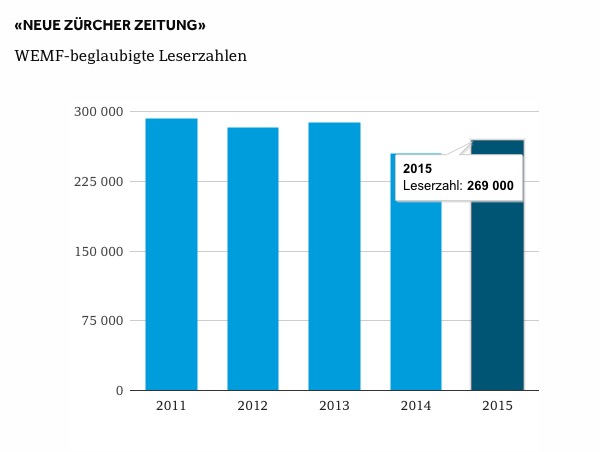
It’s become a common trope in media: As print advertising continues to evaporate and digital giants Facebook and Google suck up more and more digital advertising, publications are turning to their audience to support their journalism through subscriptions.
Large national and international publications such as the Financial Times, The Economist, and The New York Times have had relative success with this strategy by developing paid products at different price points to find audiences in the United States and internationally that are willing to pay to access their reporting.
In Switzerland, the German-language newspaper Neue Zürcher Zeitung is following their example and crafting a similar digital strategy with new paid digital products and efforts to reach German-speaking readers abroad, primarily in Germany and Austria.
“We don’t need to be the first now, but we need to follow extremely fast,” NZZ managing director Steven Neubauer told me when I met with him and NZZ new product editor Anita Zielina in Zurich.
NZZ began a major digital revamp about two years ago, and subscribers have been at the heart of those efforts. As a result, the paper has worked to improve its customer marketing, create new lower-priced digital options, build out its technology capabilities, and develop tools that enable it to capture more nuanced user data.
NZZ redesigned its website and introduced a new CMS in 2015. Last year the company also introduced five new products, including its first standalone international site in Austria, which the company is rebooting after a bumpy launch.
In 2015, NZZ, its Sunday paper NZZ am Sontag, and a handful of other affiliated publications had 149,283 paying subscribers, according to the NZZ Mediengruppe’s annual report. (Zahlende kunden means paying customers in German.)

The company made 158.4 million CHF from readers in 2015, a 1.3 percent increase from the year before. (The Swiss franc and the U.S. dollar eliminating 15 jobs. (Umsatzentwicklung nach ertagsart = sales development by income type; the first two columns represent advertising and reader revenue.)

The number of subscribers has decreased slightly or remained practically flat over the past few years. NZZ doesn’t break out print and digital subscriptions, but the report credits digital subscriptions and new products for readership growth. The site has a metered paywall, and in 2015, NZZ had an average digital and print readership of 269,000, an increase of 14,000 from 2014, according to the annual report, which cited data from the Swiss circulation auditor. (Leserzahl means reader number.)

A full print and digital subscription to NZZ costs 792 CHF ($805 U.S.) annually. In 2015, the paper introduced NZZ Selekt, an NYT Now-like app that gives users 10 stories per day for $9.99 a month, and Zielina said it’s looking at developing other entry-level products as well.
“For a lot of people, 700 or more Swiss Francs a year is a lot of money, even in a country like Switzerland where the average income is higher than in other European countries,” she said. “So that drives us to two conclusions: One is we are pretty expensive for a lot of Swiss people who would have an interest in NZZ but probably not at this price point and perhaps not toward a traditional reader who gets an e-reader app, a print paper, and digital. It’s safe to say we know that there are people out there who use digital in a way that has nothing to do anymore with this finite way of having an e-paper that basically looks like a newspaper.”
Still, NZZ isn’t chasing scale. Instead, it’s efforts are aimed at growing its subscriber base. Zielina said NZZ is working to better understand its audience and convert readers into registered users and then into paying subscribers.
“Now we are in the process, with our new data platforms, of analyzing clusters of users and identifying which cluster has a higher likelihood to convert to a paying subscriber,” she said. “The next step in the process, and that’s the thing we’re just getting started with, is to design specific, personalized products that target a certain user group where we see a likelihood to becoming a paid subscriber.”
Data, Neubauer said, is the key component to these projects. NZZ launched a customer data team about two years ago, and that team has helped the paper get improved insight into its readership.
“We combine everything into customer profiles,” he said. “We use that data to inform all of our decisions in all areas. We use it on the B2B advertising. We use it for targeting. We use it in the newsroom to decide about format, title, storytelling, etc. But we also use it for product development and product management to see, for example, what kind of features are used within a digital product, what kind of content or content categories are mostly used and which she should further push and give a higher priority.”
One of the areas where it sees potential is internationally. NZZ’s print products are distributed abroad, and more than half of the users who follow NZZ’s Facebook page come from outside of Switzerland. About 20 percent of visitors to its website come from Germany and Austria.
NZZ is still figuring out the best way to reach those readers digitally though. In 2015, the company launched a standalone site in Austria, but the site has faltered and earlier this year NZZ decided to eliminate nine Vienna-based positions.
NZZ.at was the first subscription news site in the Austrian market, Neubauer said, and NZZ decided to create the Austrian site from scratch. As a result, the user-facing design was different than what readers were used to. It was also built outside of NZZ’s existing CMS and tech platform, which made it more difficult to manage. “We changed too many things at the same time,” Neubauer said.
The Austrian site is being migrated back onto NZZ’s main platform, and the paper is rethinking its digital international strategy. In the coming months, NZZ is going to increase the number of stories it writes that are relevant for readers in Germany as it determines the best way to attempt to monetize that audience.
“Does it need to be a separate subscription product, or is better to use your core product, but with a price tag that is adjusted to the German market and to our role and our position in the German market?”
Similarly, Neubauer said there could even be an opportunity for NZZ to translate some of its stories into English to grow beyond the German-speaking market. He said international growth isn’t always about straight translation, but can rather be about the sensibility of a publication.
“I think there is a market for The New York Times to be published in other languages, which they are now pursuing, because people would explicitly like to have a U.S. view on on their country or their markets, but maybe their level of English isn’t good enough that they can read The New York Times or The Economist,” he said. “The same might hold true for us. For example, when I think about the importance of the Swiss finance industry in the world, I could well imagine there is a niche of people who would be willing to read first-hand stories of the Swiss finance market from a Swiss publisher in English. It might be only a small niche, but maybe a niche that is willing to pay a decent price for it.”
As part of that initiative, NZZ is working to eliminate silos and foster more cooperation between departments to create an understanding that subscribers are critical to NZZ’s business, regardless of whether you work in audience engagement, product development, ad sales, or elsewhere.
The technology and newsroom teams, for example, came together during the development of the new CMS. Past initiatives had ended up bloated and with unnecessary features because the departments weren’t always on the same page. But throughout CMS development, they created “a more open and transparent dialogue,” Neubauer said. That resulted in a better CMS and improved interdepartmental relationships as NZZ looks to create new products.
“Because the newsroom and technology could challenge each other much more openly, they could prioritize much better, and they could design workflows and processes that are much more adapted to the new digital world,” he said. “We have now a very smooth process of introducing it and really tremendous improvement in efficiency and effectiveness of the new content management system. It’s a huge step for us in the digital transformation.”
NZZ is using this process to develop a more personalized content recommendation that will end up in a new app, which NZZ is calling the Companion App. The project is funded through the Google Digital News Initiative.Here’s how Zielina explained the idea behind the Companion App: Traditional content recommendation services suggest stories based on what you’re reading. So if you’re reading a story about Donald Trump, a typical news site will suggest you read more coverage of Trump or the presidential campaign.
With the Companion App, NZZ wants to develop a content recommendation method that better matches people’s reading habits, meaning that if you’ve already read one story about Trump, you might not want another one about the GOP nominee. Instead, you might want to read something from the style or sports sections. In a LinkedIn post announcing the project, Zielina explained that the goal is to create “data driven, context-aware, authentic journalism experiences.”
But beyond the app, the paper is planning to introduce the personalization mechanisms into its other platforms as well so it will be able to tailor content to users based on their device, location, time of day, and more. And ultimately, they want to use their learnings for all areas of NZZ’s business.
“The idea is to build this layer, build an app, but then include it in all products, whether its political journalism or classifieds,” Zielina said in our Zurich meeting. “Including that level of personalization works across all topics.”
NZZ plans to launch the algorithm and the Companion App next summer.
The paper is already looking at user behavior to inform new product decisions, though. When NZZ redesigned its website last year, it introduced a news digest that summarizes key events in short paragraphs with links to other stories offering more detail.
The digest is updated regularly from 6 a.m. through midnight, but twice a day — in the morning and the evening — NZZ sends out a version of the news digest in an email newsletter.
Zilena didn’t specify the size of the newsletter’s audience, but she said the news digest has about a 40 percent open rate and a clickthrough rate of about 20 percent.
Most of the consumption of the digest, both online and via the newsletter, comes via mobile, so Zielina said she could foresee eliminating it on desktop, and making it more prominent on mobile.
“Context and user situation drive us in our user engagement,” she said. “This is one example of how we try to figure out the users’ need and try to adapt to that need and build something specifically for that need.”
And as NZZ figures out its path forward in the digital world, Zielina and Neubauer emphasized that the paper will continue to experiment and find ways to present its journalism and reach new audiences.
“A news company is not a nuclear power plant,” Neubauer told me. “We can experiment. It’s not a matter of life or death.”